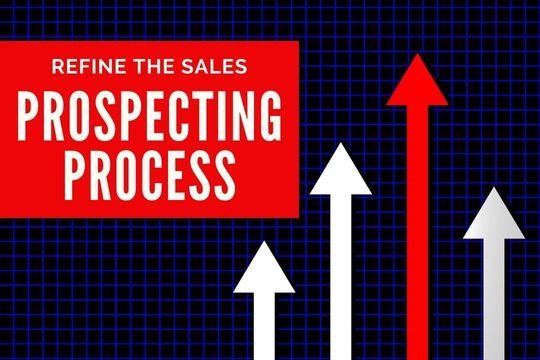
Prospecting is a term that emerged from the California Gold Rush of 1849 through the 1850s. That's when people worldwide began to populate what became the "Golden State." The dream and challenge of these travelers were to search for the shiny metal in a vast landscape through mining, digging, and panning.
Sales prospecting is a similar journey, except it's about finding new customers instead of gold. Here's a look at the modern sales prospecting process to convince prospects to buy your product or service.

There's an important distinction between a sales pipeline and a sales funnel. A sales pipeline is a series of stages the prospect goes through that lead to a purchasing decision. A sales funnel, by contrast, reflects the conversion rates of prospects who become customers after advancing through your sales pipeline.
Along the customer journey should be landing pages on your website that provide deeper information to satisfy their curiosity. Here are essential steps to build an effective sales pipeline:
Once you've developed your sales pipeline, you'll need to audit, test, and refine it. Many of today's retail chains have streamlined their sales pipelines with smart technology that tracks store customer behavior. Managers can tap into real-time data on a smart device that reveals which parts of the store get the most traffic. This data helps narrow down leads to the most viable prospects.
Once you score and prioritize your leads, you'll be able to assemble a useful prospect list that will allow for quicker sales than a random list. A Customer Relationship Management (CRM) software platform is the best way to manage a prospect list. This platform is a powerful hub that your sales team can access to research or add information to customer profiles based on customer conversations. These profiles provide contact information, making it easy to automate sending email messages to prospects and customers.
Sending sales emails to prioritized leads is an important building block toward establishing a loyal customer base. Although your CRM software can automate these emails, it's still essential to personalize each email to match a prospect or customer's profile.
One way to simplify and sharpen your target marketing is to create sales personas to reflect various segments of your market. A sales persona can be made visually through a photo, avatar, or symbol. You can develop different sales and marketing strategies to reach different market segments.

The most successful companies employ sales professionals who know how to communicate well with a consumer or business decision-maker. The key is for sales reps to believe in what they're pitching and utilize the right tools that help direct prospects through their journey of learning your brand. Winning sales reps understand the need to learn about every prospect's concerns and nuances.
Developing a productive sales team involves strong leadership and a clear set of proven sales strategies. Your team will be much more cohesive if each member is trained to be on the same page regarding company vision and business goals. Through training sessions, you can explain your sales strategies in detail. Make sure each team member you hire is someone who fits and likes your brand and business culture. They must also display energy and enthusiasm to close deals.
The structure of your sales prospecting process begins with company size. Training will be easier and more personalized if it's a small company. Still, if it's a large firm, you may want to diversify training so that it can be executed through physical and virtual experiences.
You need a sales team that cares enough about your products and services to build an impressive knowledge base. Your team should be able to spark upbeat conversations about your offerings with prospects. Each sales team member must understand how to approach sales to lead on a personal level.
It's important to note that prospecting and sales should be viewed as two distinct processes within the same pipeline. Prospecting is more about finding and qualifying leads, while the sales process is about converting leads, which involves the following steps:

These days, sustainability is a core value for many businesses because it covers improving environmental, social, and governance conditions. A workplace needs to be safe, fair, and transparent. Otherwise, suspicion about the operation may spread. Sales teams are more productive if the work environment is friendly, energetic, and positive.
Maintaining a sustainable workplace includes creating flexibility for each employee based on their personal needs. Many sales reps work so hard that they don't get to spend much time with their families, so they must understand how to stay healthy to prevent burnout.
Another dimension of team building is collaboration. It's important to let each team member feel they can contribute to the whole team through their sales efforts and creative ideas. Group brainstorming sessions are a good way to get all team members to participate. The more your sales team feels their participation matters, the more you'll be able to forecast sales from team motivation accurately.
At the core of a sales philosophy should be that every sales lead matters. But not every lead can be expected to convert shortly, so cold leads should be saved for nurturing later. During the prospecting process, a sales agent must ask relevant questions to assess if the individual can be classified as a "hot," "warm," or "cold" lead. Some companies have different names for these same concepts or use a scoring system to evaluate each prospect.
Lead scoring can be based on any system you choose that qualifies leads as probable or possible sales. Even a cold call that doesn't convert can still be the root of a long relationship, so cold leads need to be set aside for future nurturing. The often overlooked advantage of any cold call is it can tap into a household of potential customers. Potential buyers interested in your product might not buy immediately but may be persuaded to buy later if you give them more information.

Different closing techniques exisst for different types of products and services. A sales manager's job is to shape a framework for closing deals. If all sales reps follow the same procedures, evaluating the sales process and individual sales reps is much easier.
Closing is somewhat different from a phone call compared with an in-person conversation. The rep can follow a script or outline on the phone, whereas closing a deal in person requires a strong memory of details. Many retail sales agents now carry laptops to help answer questions quickly. Regardless of the specific approach to getting the prospect to say "yes," here are the four general steps to closing most sales deals:
Treating prospects like gold makes the sales prospecting process much easier. For more tips on increasing sales and improving your business operations, subscribe to our small business emarketing newsletter today!
A sales pipeline outlines the specific stages a prospect travels toward purchase, whereas a sales funnel illustrates the percentage of prospects that progress through those stages and ultimately become customers. The pipeline shows actions; the funnel shows conversion rates.
A CRM centralizes prospect and customer data, lets reps track interactions, automate personalized emails, prioritize leads, and share insights across the team. This visibility speeds follow-ups, prevents missed opportunities, and supplies managers with metrics to refine strategies and forecast revenue.
Assign each lead a score based on factors like budget, need, authority, timeline, past engagement, and demographic fit. Classify high scores as hot, medium as warm, and low as cold. Focus resources on hot leads first, nurture warm ones, and schedule periodic touches for cold prospects.
Seek reps who genuinely believe in your offering, communicate clearly, listen actively, and show energy and resilience. They must align with your brand culture, learn quickly, use digital tools comfortably, and commit to understanding each prospect's pain points to craft helpful, personalized solutions.
Evaluate the prospect's needs, anticipate likely objections, engage with personalized communication, offer concise rebuttals, and finally ask for the commitment or schedule future nurturing. Following these five steps consistently helps reps overcome barriers and turn qualified prospects into satisfied customers.